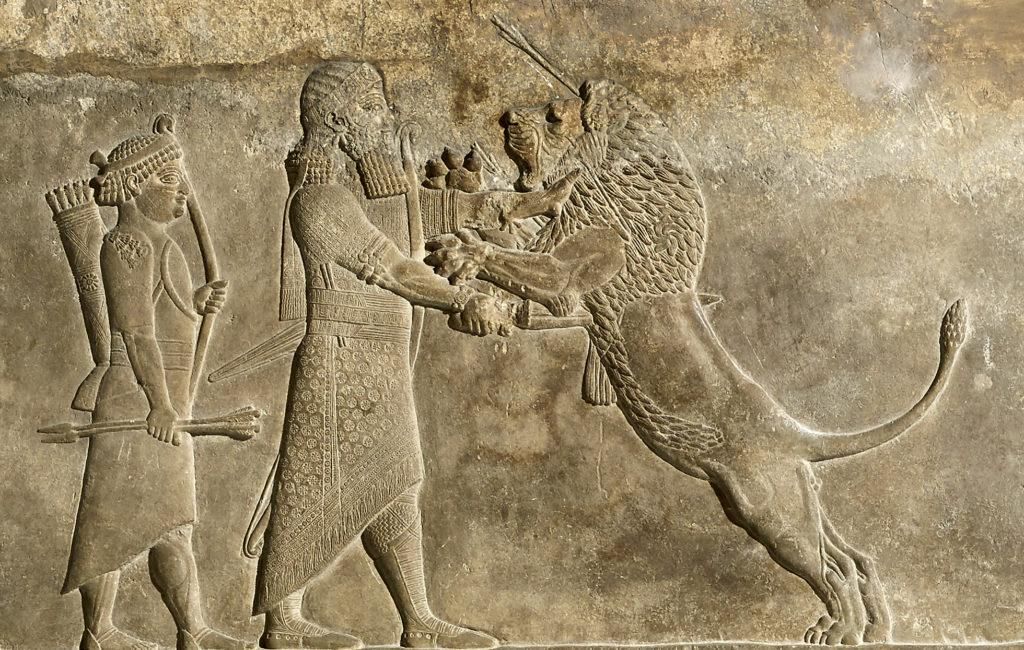
Israel's (and much of her neighbours') most implacable enemies, the Assyrian Empire had had a long history before Israel came into existence as a nation. It was also the Assyrians who, in 722 BC, sacked Samaria and deported the ten northern tribes of Israel into exile and demise from history. Their attempt to conquer Jerusalem in 701 BC, during the reign and leadership of King Hezekiah and the prophet Isaiah, failed when, according to the Historian, "the angel of the Lord went out and put to death a hundred and eighty-five thousand men in the Assyrian camp" (2 Ki 19:35"). By the last quarter of the 7th Cent, however, the empire was already failing, and finally defeated by the combined forces of the Babylonians and Medes at Haran in 609, and faded from history.

Open Map ☰
The earliest history of the Assyrians remain uncertain. By the 14th Cent BC, however, the city-state—making its wealth from a broad network of trade connections amidst the Fertile Crescent—had already extended its boundary to the Euphrates in the west and stood as a regional power with Egypt and the Hittites. After centuries as a superpower in the region, it lapsed into a "Dark Age" sometime in the mid-11th Cent. This coincided with a similar retreat of Egyptian influence in the region, permitting Israel—newly arrived in Canaan—to establish itself after their exodus from Egypt. This was also what made it possible, politically speaking, for David and Solomon to extend Israel's control as far as north as it did in their time.
By late 10th Cent, however, Assyria rediscovered its old rigour and began pushing the envelope of its influence and hegemony westward, and under Ashurnasipal (c. 889-858), its territorial claim reached the Euphrates again. It went quiescent again for a short while but resurged especially under the leadership of Tiglath-Pileser II; it was with this resurgent Assyria that Israel had to contend as is reflected in the books of Kings. The fall of the northern state of Israel and the disenfranchisement of its ten tribes, the fall and destruction of Lachish, and the failed invasion of Jerusalem fell to this season of Assyrian power. But, already, its enemies were building up their muscles. About 655 BC, Egypt had already stopped paying tribute and there was nothing Assyria could do about it. Babylon had already made an attempt at independence in 652, though it was put down. Soon other nations, like Elam and Media, also began to reassert their independence. Then Ashurbanipal's brother, who ruled as a deputy in Babylon, rebelled in against him 642. The Arabs took the opportunity to attack many of the vassals in the south like Moab and Edom. In 629 BC the aging Ashurbanipal brought his son Sinshar-ishkun into a co-regency with him. When Ashurbanipal died three years later, civil war broke out and Sinshar-ishkun's claim to the throne was challenged. Though Sinshar-ishkun eventually came out victorious, the civil war further weakened the once super-power already in decline.
The death-knell for Assyria came when a Chaldean prince by the name of Nabopolassar laid siege to the city of Babylon in October 626 and was able to defeat the Assyrian forces there the following month and capture the city for himself and setting down the foundations for the neo-Babylonian empire to come. By 616 he could march up the Euphrates and defeat the Assyrian forces in the Assyrian heartland later that year. Four years later, the Assyrian capital of Nineveh fell to the combined forces of the Medes and Babylonians. Surviving Assyrians, with Ashur-uballit II as their leader, fled north towards Haran, where they hope to make a last stand. Egypt—seeing the loss of her influence in the region should the Babylonians come out victorious and hoping to establish a balance of power advantageous to them—rushed north to help the Assyrians, but arrived too late. (They fought King Josiah while transiting the Valley of Jezreel, killing the young king in the process, 2Ki 23:29-30). By then, however, the Assyrian had already met their end at the hands of the Babylonians.

Six Assyrian kings are mentioned in the OT:
Shalmaneser III, c.858-824.
(2 Ki 17:3, 4; 18:9)
Tiglath-Pileser III, c.745-727.
(2 Ki 15:29; 16:7, 10; 1 Chron 5:6, 26; 2 Chron 28:20)
Sargon II, r.722-05.
(Isa 20:1)
Sennacherib, r.705-681.
(2 Ki 18:13; 19:9, 16, 20,36; 2 Chron 32:1, 2, 9, 10, 16, 22; Isa 36:1; 37:9, 17, 21, 37)
Esarhaddon, r.681-669.
(2 Ki 19:37; Ezr 4:2; Isa 37:38)
Ashurbanipal, r.669-627.
(Ezra 4:10)

Resources:
Caleb Howard, "Who Were the Assyrians?" Article: Tyndale House, 8 April 2021.
Webpage N 5-6 (Open on Phone)
Gareth Brereton, "Introducing the Assyrians," The British Museum, London. 19 June 2018.
Blog N

©ALBERITH
100819lch